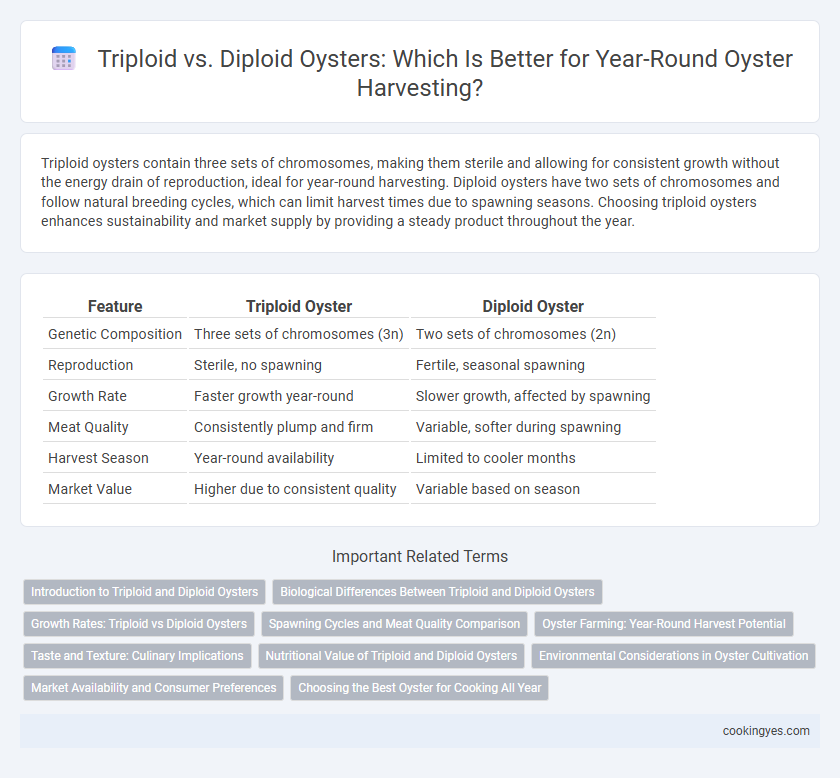Triploid oysters contain three sets of chromosomes, making them sterile and allowing for consistent growth without the energy drain of reproduction, ideal for year-round harvesting. Diploid oysters have two sets of chromosomes and follow natural breeding cycles, which can limit harvest times due to spawning seasons. Choosing triploid oysters enhances sustainability and market supply by providing a steady product throughout the year.
Table of Comparison
| Feature | Triploid Oyster | Diploid Oyster |
|---|---|---|
| Genetic Composition | Three sets of chromosomes (3n) | Two sets of chromosomes (2n) |
| Reproduction | Sterile, no spawning | Fertile, seasonal spawning |
| Growth Rate | Faster growth year-round | Slower growth, affected by spawning |
| Meat Quality | Consistently plump and firm | Variable, softer during spawning |
| Harvest Season | Year-round availability | Limited to cooler months |
| Market Value | Higher due to consistent quality | Variable based on season |
Introduction to Triploid and Diploid Oysters
Triploid oysters contain three sets of chromosomes, making them sterile and able to grow continuously throughout the year without diverting energy to reproduction. Diploid oysters have two sets of chromosomes and undergo spawning cycles, which can slow growth and affect taste during breeding seasons. Triploid oysters provide a reliable, year-round harvest option, while diploids offer traditional flavor profiles but with seasonal availability.
Biological Differences Between Triploid and Diploid Oysters
Triploid oysters contain three sets of chromosomes, rendering them mostly sterile and preventing energy diversion to reproduction, which supports continuous growth and allows for year-round harvest. Diploid oysters possess two sets of chromosomes and undergo a natural reproductive cycle that can reduce meat quality and halt growth during spawning seasons. The triploid's biological advantage lies in its enhanced growth and consistent meat plumpness, critical for commercial farming and market availability throughout the year.
Growth Rates: Triploid vs Diploid Oysters
Triploid oysters exhibit faster growth rates compared to diploid oysters due to their sterile nature, which allows energy to be diverted from reproduction to somatic growth. This accelerated growth enables triploid oysters to reach market size more quickly, supporting year-round harvests with consistent yield. Diploid oysters, while slower-growing, offer natural breeding cycles but may have limited availability during spawning seasons, affecting continuous production.
Spawning Cycles and Meat Quality Comparison
Triploid oysters, engineered with three sets of chromosomes, exhibit suppressed spawning cycles, enabling consistent, high-quality meat production year-round, unlike diploid oysters that spawn seasonally, resulting in fluctuating meat quality and texture. The sterility of triploid oysters prevents energy diversion to gonad development, maintaining plump and firm meat even during typical spawning periods that cause diploid oysters to become watery and less desirable. This genetic advantage makes triploid oysters highly preferred in aquaculture for maximizing harvest efficiency and delivering superior product consistency throughout the year.
Oyster Farming: Year-Round Harvest Potential
Triploid oysters, possessing three sets of chromosomes, offer significant advantages for year-round oyster farming compared to diploid oysters, which have two sets of chromosomes. Their sterility prevents energy diversion to reproduction, enabling continuous growth and consistent harvests regardless of season. This trait makes triploid oysters highly favored in aquaculture for maintaining supply stability and optimizing farm productivity throughout the year.
Taste and Texture: Culinary Implications
Triploid oysters, sterile and genetically modified, offer a plumper texture and a sweeter taste due to their inability to spawn, making them ideal for consistent year-round harvests. Diploid oysters undergo natural reproductive cycles, resulting in a leaner texture and a milder flavor during spawning seasons, which can affect culinary quality. Chefs favor triploid oysters for their richer mouthfeel and enhanced brininess, while diploid varieties are prized for seasonal freshness and classic taste profiles.
Nutritional Value of Triploid and Diploid Oysters
Triploid oysters, being sterile, allocate more energy to growth, resulting in a consistently plump texture and higher glycogen content, which enhances their nutritional profile with increased protein and essential fatty acids year-round. Diploid oysters undergo reproductive cycles that cause fluctuations in their nutrient composition, typically exhibiting lower levels of glycogen and protein during spawning seasons. As a result, triploid oysters provide a more reliable source of nutrients such as omega-3 fatty acids, vitamins A and B12, and minerals like zinc and iron throughout the year.
Environmental Considerations in Oyster Cultivation
Triploid oysters, sterile and often grown for year-round harvest, reduce the risk of overbreeding in natural oyster populations, thus minimizing ecological disruption compared to diploid oysters that reproduce seasonally. The sterility of triploids prevents genetic dilution and potential competition with wild oyster stocks, promoting healthier marine ecosystems. Diploid oyster cultivation requires seasonal harvesting to prevent spawning-induced quality decline, which can strain marine environments during peak breeding times.
Market Availability and Consumer Preferences
Triploid oysters, which contain three sets of chromosomes, are favored for year-round harvest due to their sterility, preventing spawning and maintaining plump, marketable meat quality throughout the year. Diploid oysters, possessing two sets of chromosomes, spawn seasonally, resulting in a temporary decline in meat quality and market availability during warmer months. Consumer preferences lean towards triploid oysters for consistent taste and texture, while diploids are often preferred for traditional flavor profiles experienced outside spawning seasons.
Choosing the Best Oyster for Cooking All Year
Triploid oysters, containing three sets of chromosomes, are ideal for year-round harvest due to their sterility, which prevents spawning and maintains consistent meat quality and size throughout the year. Diploid oysters, with two sets of chromosomes, spawn in warmer months, resulting in a soft texture and reduced flavor that may not be suitable for cooking during spawning season. Selecting triploid oysters ensures a steady supply of firm, flavorful oysters perfect for culinary use across all seasons.
Triploid Oyster vs Diploid Oyster for Year-Round Harvest Infographic

 cookingyes.com
cookingyes.com